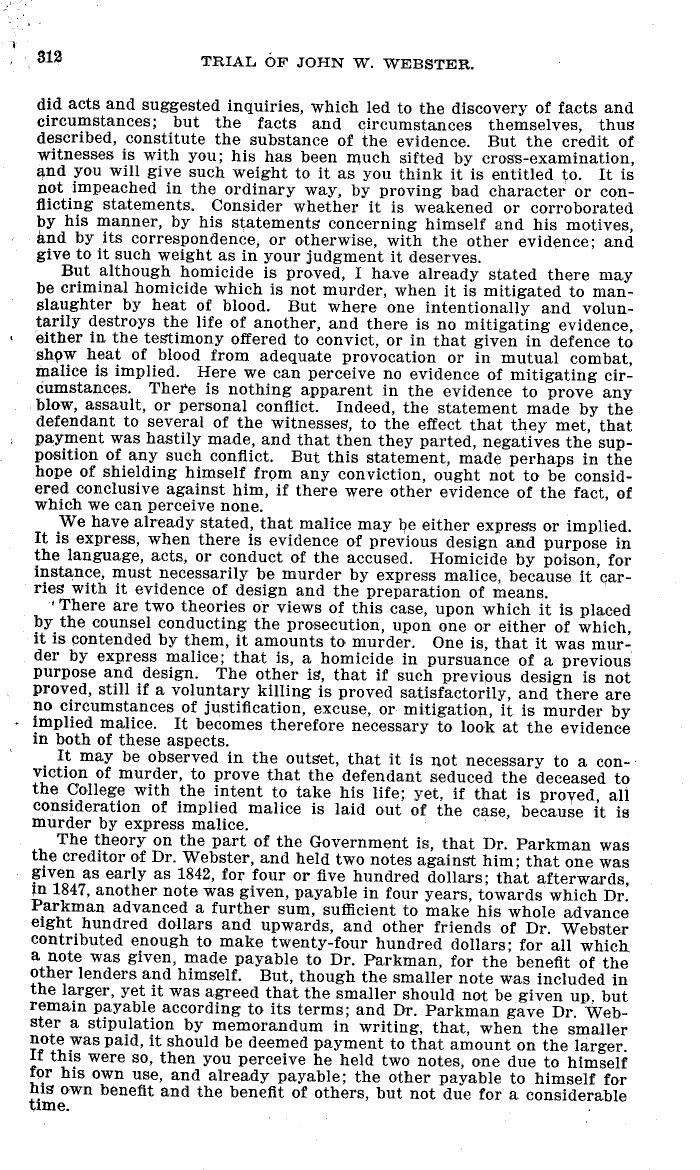|
~1~ TRIAL OF JOHN W. WEBSTER.
did acts and suggested inquiries, which led to the discovery of facts and
circumstances; but the facts and circumstances themselves, thus
described, constitute the substance of the evidence. But the credit of
witnesses is with you; his has been much sifted by cross-examination,
and you will give such weight to it as you think it is entitled to. It is
not impeached in the ordinary way, by proving bad character or con-
flicting statements. Consider whether it is weakened or corroborated
by his manner, by his statements concerning himself and his motives,
and by its correspondence, or otherwise, with the other evidence; and
give to it such weight as in your judgment it deserves.
But although homicide is proved, I have already stated there may
be criminal homicide which is not murder, when it is mitigated to man-
slaughter by heat of blood. But where one intentionally and volun-
tarily destroys the life of another, and there is no mitigating evidence,
either in the testimony offered to convict, or in that given in defence to
show heat of blood from adequate provocation or in mutual combat,
malice is implied. Here we can perceive no evidence of mitigating cir-
cumstances. There is nothing apparent in the evidence to prove any
blow, assault, or personal conflict. Indeed, the statement made by the
defendant to several of the witnesses, to the effect that they met, that
payment was hastily made, and that then they parted, negatives the sup-
position of any such conflict. But this statement, made perhaps in the
hope of shielding himself from any conviction, ought not to be consid-
ered conclusive against him, if there were other evidence of the fact, of
which we can perceive none.
We have already stated, that malice may be either express or implied.
It is express, when there is evidence of previous design and purpose in
the language, acts, or conduct of the accused. Homicide by poison, for
instance must necessarily be murder by express malice, because it car-
ries with it evidence of design and the preparation of means.
I There are two theories or views of this case, upon which it is placed
by the counsel conducting the prosecution, upon one or either of which,
it is contended by them, it amounts to murder. One is, that it was mur-
der by express malice that is, a homicide in pursuance of a previous
purpose and design. The other is, that if such previous design is not
proved, still if a voluntary killing is proved satisfactorily, and there are
no circumstances of justification, excuse, or mitigation, it is murder by
implied malice. It becomes therefore necessary to look at the evidence
in both of these aspects.
It may be observed in the outset, that it is not necessary to a con-
viction of murder, to prove that the defendant seduced the deceased to
the College with the intent to take his life; yet, if that is proved, all
consideration of implied malice is laid out of the case, because it is
murder by express malice.
The theory on the part of the Government is, that Dr. Parkman was
the creditor of Dr. Webster, and held two notes against him; that one was
given as early as 1842, for four or five hundred dollars; that afterwards,
in 1847, another note was given, payable in four years, towards which Dr.
Parkman advanced a further sum, sufficient to make his whole advance
eight hundred dollars and upwards, and other friends of Dr. Webster
contributed enough to make twenty-four hundred dollars; for all which
a note was given, made payable to Dr. Parkman, for the benefit of the
other lenders and himself. But, though the smaller note was included in
the larger, yet it was agreed that the smaller should no be given up, but
remain payable according to its terms; and Dr. Parkman gave Dr. Web-
ster a stipulation by memorandum in writing, that, when the smaller
note was paid, it should be deemed payment to that amount on the larger.
If this were so, then you perceive he held two notes, one due to himself
for his own use, and already payable; the other payable to himself for
his own benefit and the benefit of others, but not due for a considerable
time.
|

